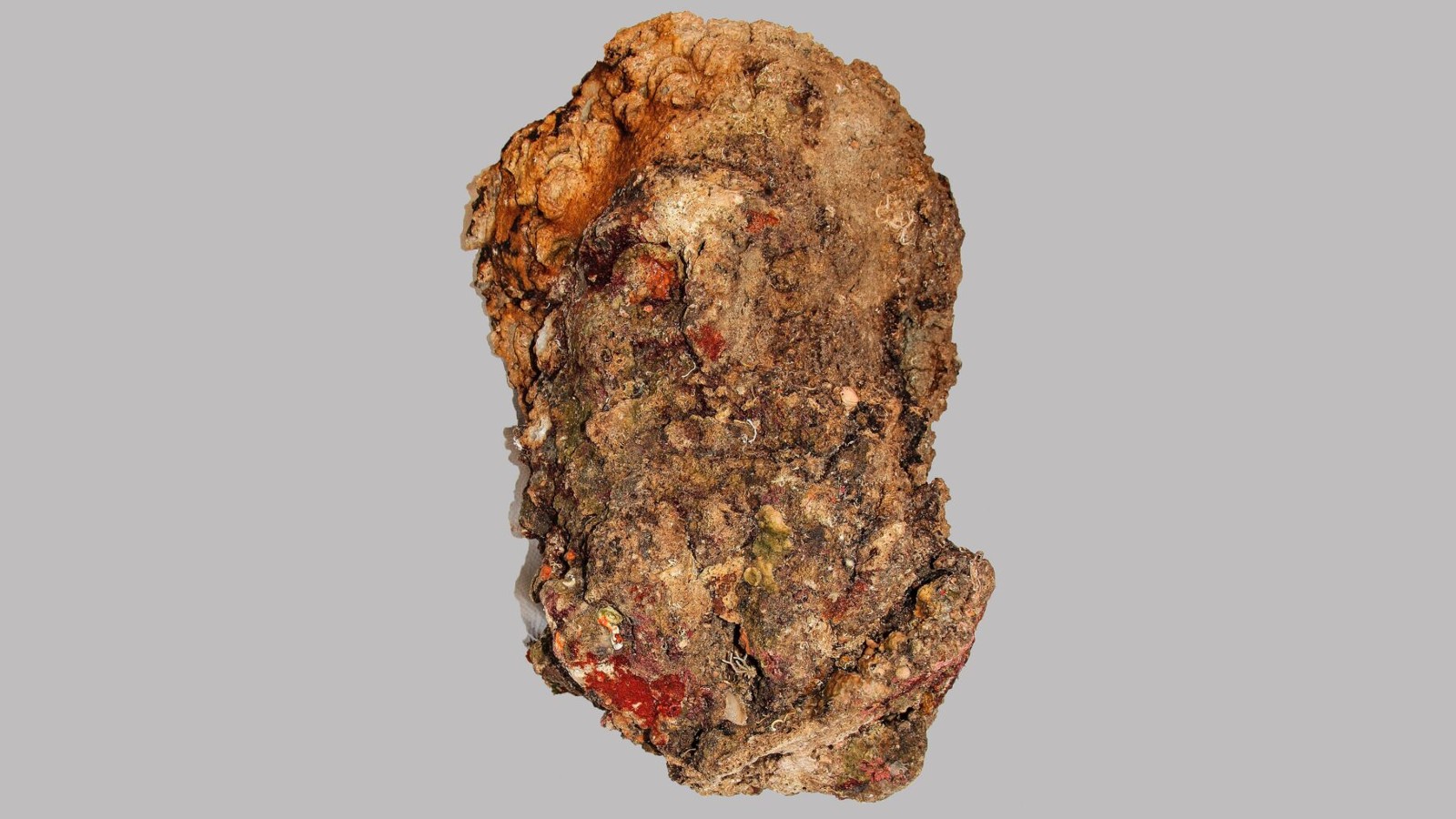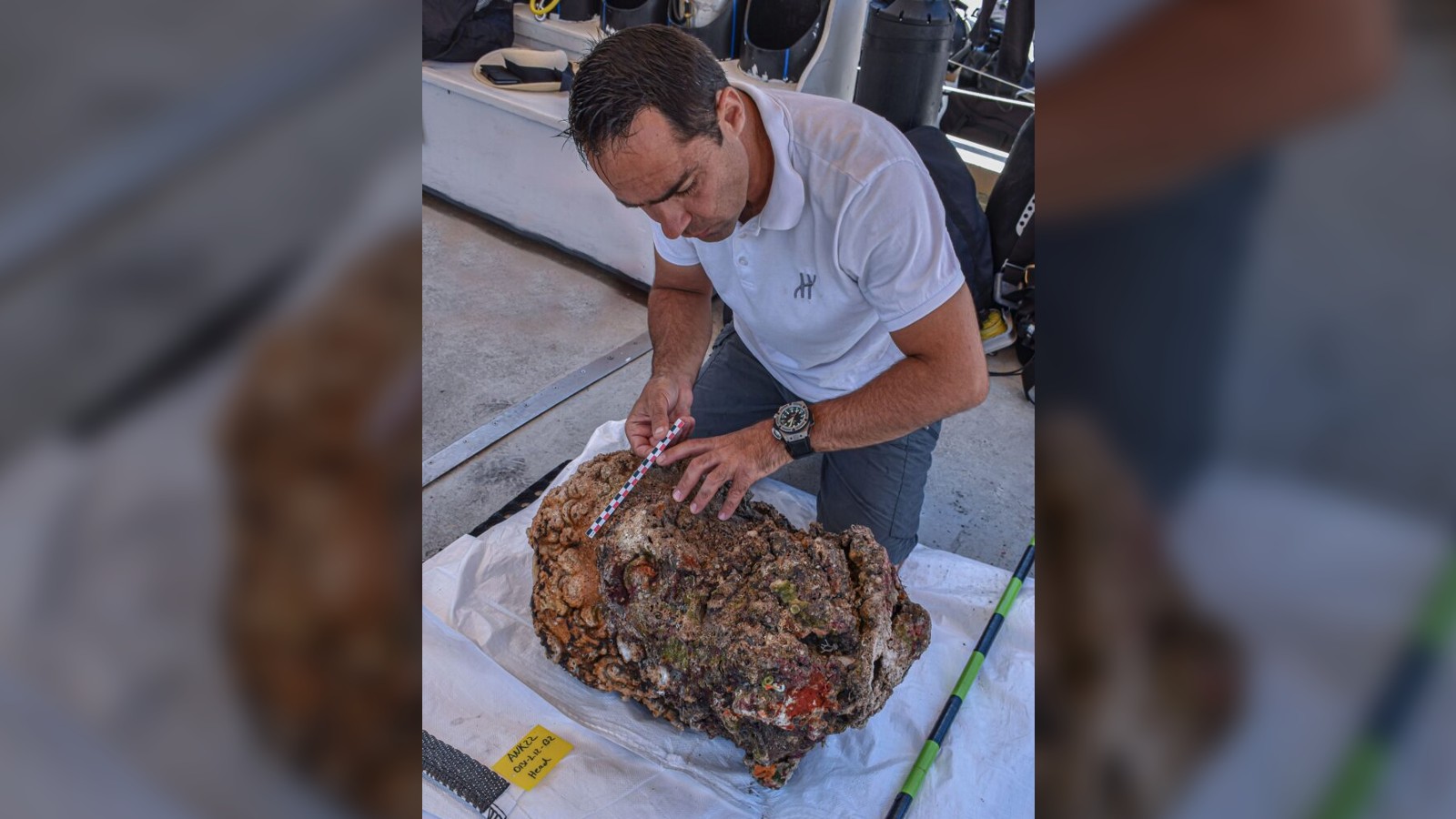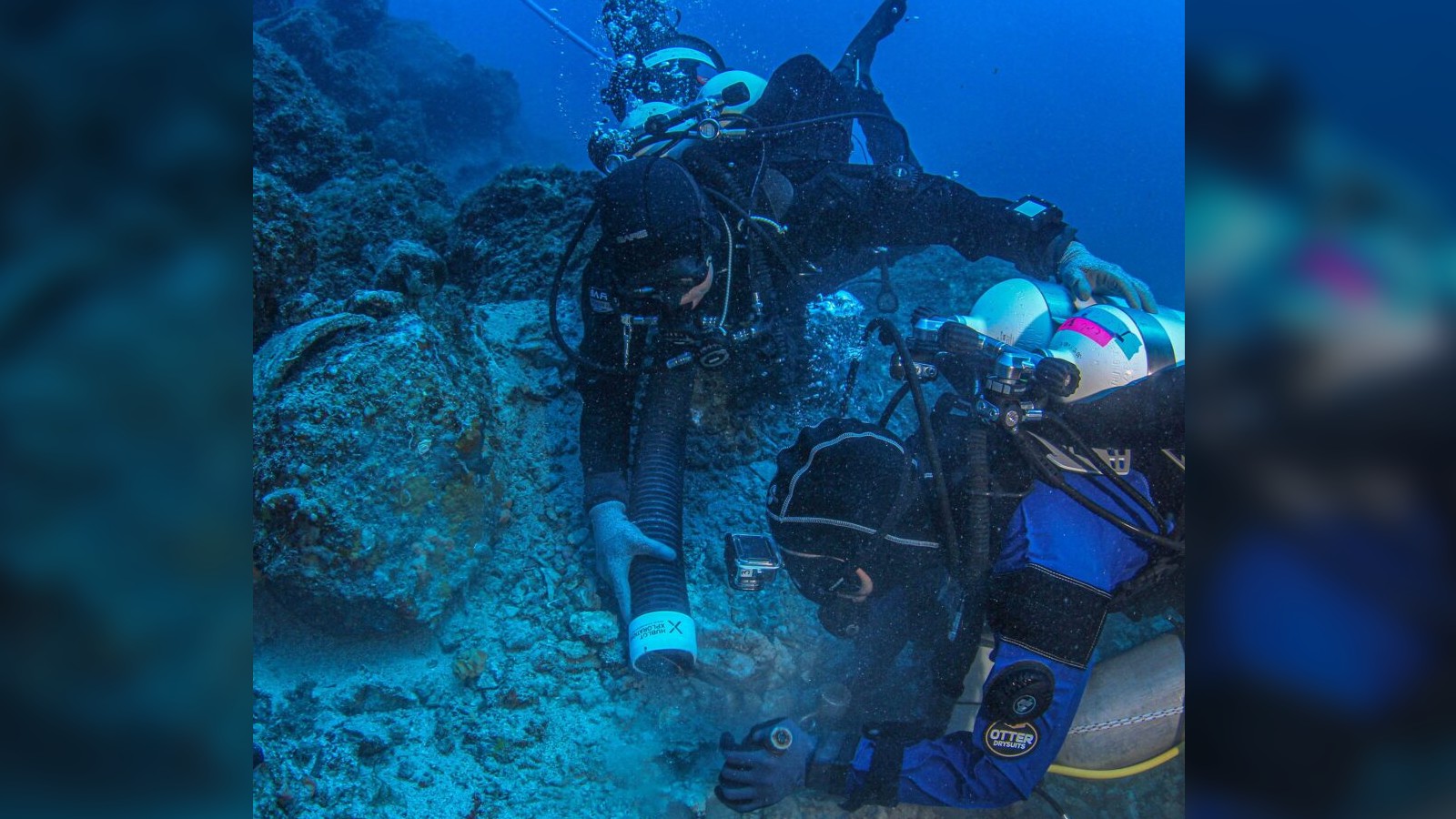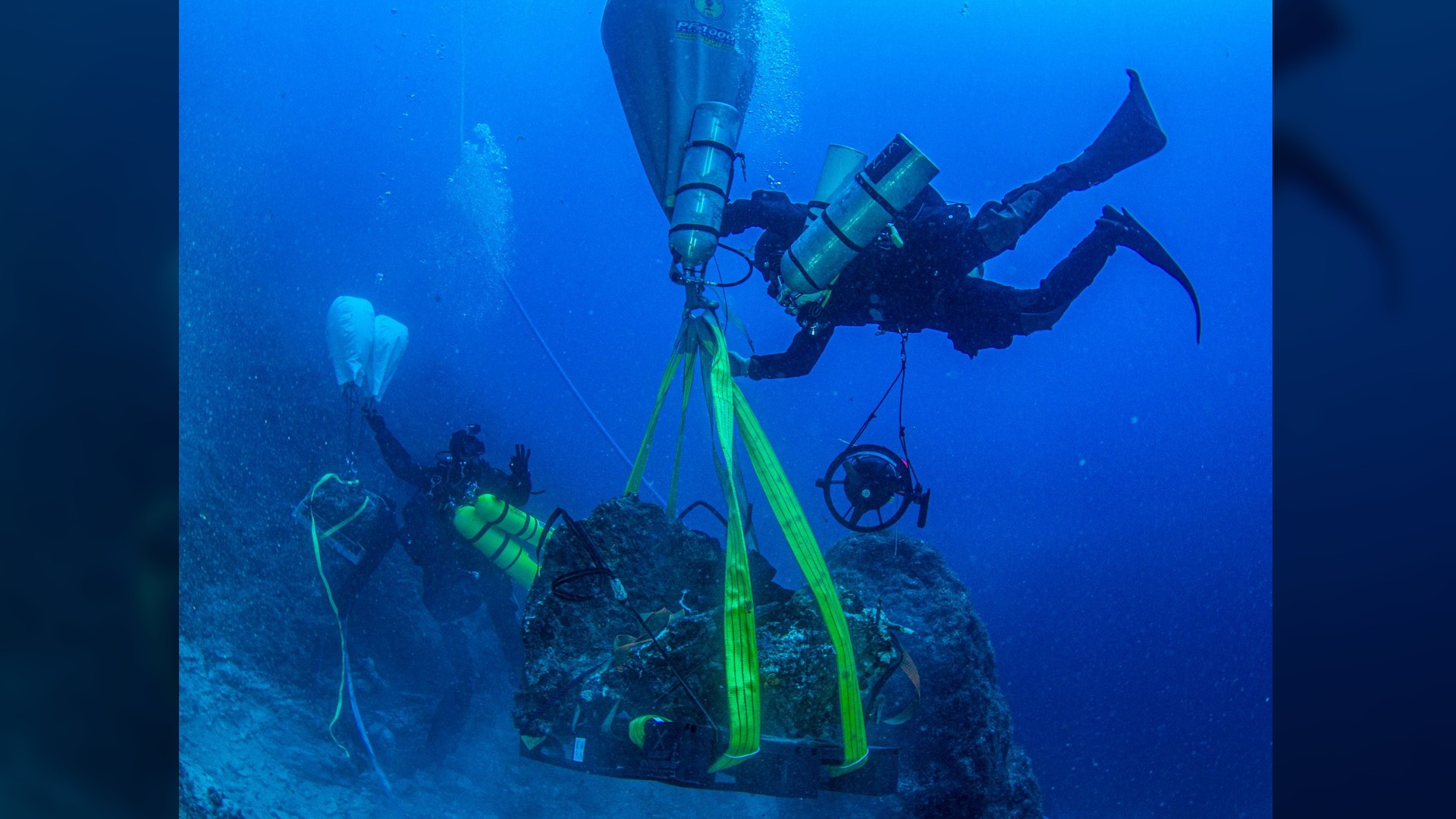Head of Hercules and other treasures found on Roman 'Antikythera Mechanism' shipwreck
Divers also found bronze and marble statues, including of horses.
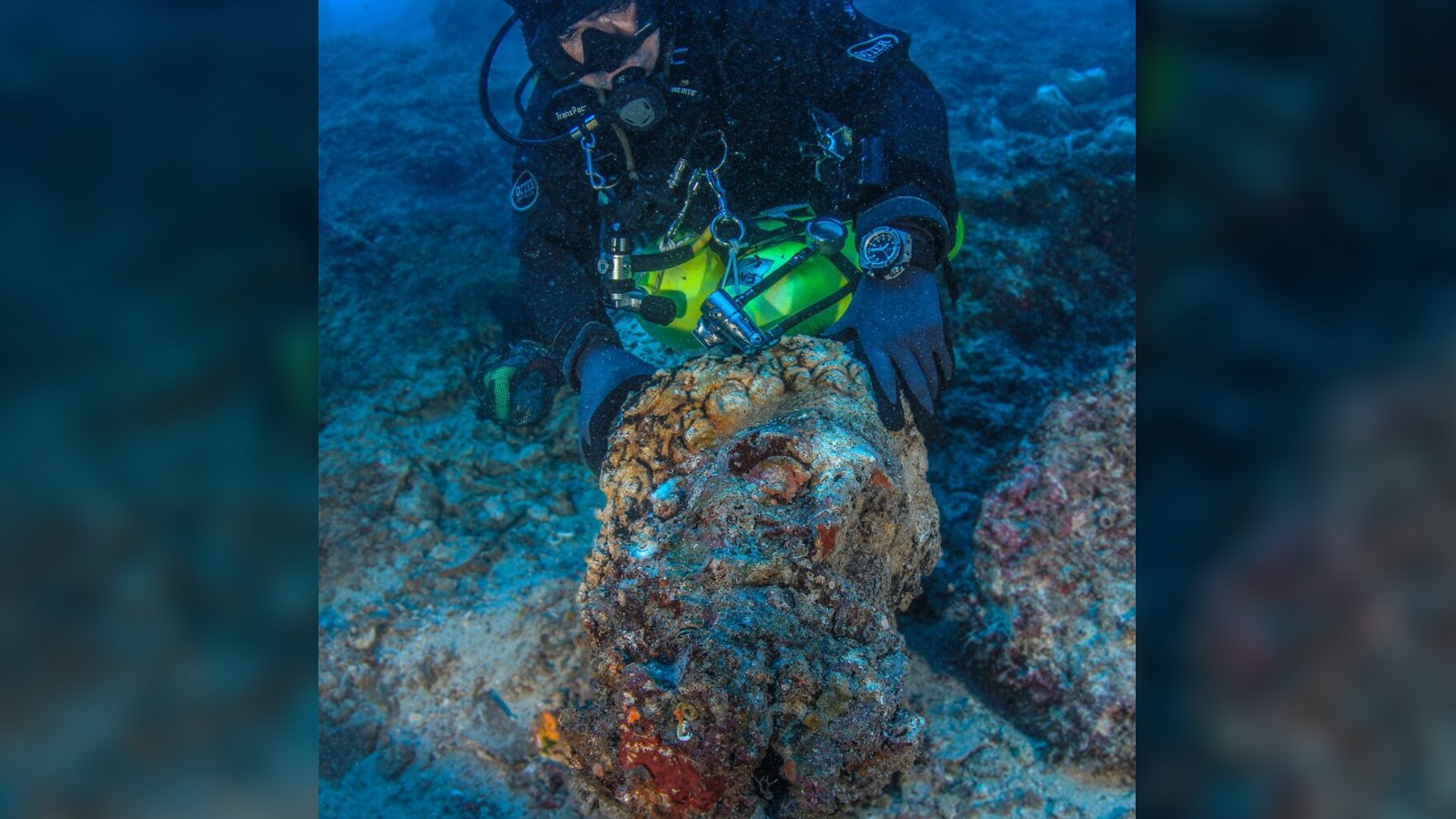
The 2,000-year-old Roman shipwreck that carried the Antikythera Mechanism — a precise mechanical model of the sun, moon and planets — is giving up new treasures, including a marble head thought to depict the Greek and Roman demigod Hercules.
Scientists and divers made the new discoveries after creating the first phases of a precise digital 3D model of the shipwreck, which sank near Antikythera, a Greek island in the southern Aegean Sea, in about the second quarter of the first century B.C. The digital model — which the scientists made with thousands of underwater photographs of the seafloor site, using a technique called photogrammetry — could help in the search for more pieces of the mysterious geared mechanism, the team said.
The model has already enabled archaeologists to identify and remove several large boulders that tumbled over the wreck site after an earthquake, which occurred sometime after the ship sank. The removal of the boulders revealed an area that’s thought to be within the ancient ship's hull and contained the latest finds, including the massive marble head of a sculpture thought to represent the Greek demigod Herakles (Hercules in Latin), according to a statement by the expedition team. It’s almost certain that the head came from the headless sculpture of a human body that was found during the first expedition to recover objects from the wreck after it was discovered by sponge divers in 1900.
Related: The 25 most mysterious archaeological finds on Earth
The salvage divers working over 100 years ago also found the remains of the Antikythera Mechanism — now on display in at the National Archaeological Museum in Athens — so it's likely that both the statue and the mechanism were located in roughly the same area of the ship, Lorenz Baumer, a classical archaeologist at the University of Geneva in Switzerland and co-leader of the expeditions. told Live Science.
But "the site is quite big," he said. "It's some 50 meters [164 feet] across, and it's covered by rocks. It's possible that [more fragments] are hiding in the rocks, but they could be anywhere."
Ancient shipwreck
Baumer and his colleagues are taking part in the latest effort to investigate the Antikythera wreck, along with scientists from Greece's Ephorate of Underwater Antiquities; divers from the Greek coast guard; scientists at the Ca' Foscari University of Venice; and a dive team from the Swiss watchmaking company Hublot, which devised the underwater lifting equipment of pressurized airbags used to remove the overlying boulders, some of which weighed about 9.5 tons (8.5 metric tons).
Get the world’s most fascinating discoveries delivered straight to your inbox.
Although the ship at Antikythera is thought to have been about 180 feet (55 m) long, according to the Woods Hole Oceanographic Institution in Massachusetts, the wooden hull has since rotted away, and only pieces of the rich cargo it once carried have been found, Baumer said.
It's not known how the ship sank — whether it tipped over and dumped its cargo out, for instance — or in what position it came to rest on the seafloor, he said. It now lies at a depth of about 150 feet, just off a northern point of the island.
The excavations completed during the latest expedition, in May and June 2022, focused on a small area exposed after the boulders were lifted from the site. In addition to the head of the marble statue, the team found two human teeth within a glob of marine deposits and fragments of copper and wood.
Scientists hope to analyze isotopes in the enamel of the teeth. Isotopes are variations of chemical elements that have lost neutrons from radioactive decay, and can reveal the geochemistry of the environment when the teeth formed. The isotopes could help scientists determine a person's diet or place of origin, and the teeth might even contain fragments of DNA, Baumer said. Archaeologists will also look for more human remains where the teeth were found.
Mysterious mechanism
The ancient ship was filled with Greek artworks when it sank — it contained several bronze statues and more than 38 marble sculptures, including of horses — and it seems likely that it was being transported to Italy on behalf of wealthy Romans or to be sold to them, Baumer said.
Dives to the Antikythera wreck over the more than 120 years since it was found have recovered several bronze and marble sculptures, precious glassware and a bronze lyre that may have come from a statue of Eros (the Greek god of desire) or Apollo (the Greek god of the sun, music and knowledge).
The latest excavations also found a marble base portraying the lower legs of a statue; bronze and iron nails; the lead collar from a wooden anchor; and several shapeless fragments of iron that will be examined with X-rays and other laboratory analytical techniques, Baumer said.
One of the goals of the latest project is to determine precisely where the fragments of the Antikythera Mechanism were found during the first salvage expedition in 1900 and 1901, Baumer added.
Only about half of the mechanism has been recovered, so it's possible that more pieces could be found. "We joke that we will find a box with 10 more of them," Baumer said.
Mike Edmunds, an astrophysicist at the University of Cardiff in the United Kingdom and the lead scientist on the multidisciplinary Antikythera Mechanism Research Project, said that finding more of the mysterious object could help resolve questions about an additional function of the mechanism that's hinted at by the Greek inscriptions on its surface.
It now seems that the mechanism's model of the positions of the sun and moon was supplemented by gears to show the positions of the major planets within the celestial zodiac. But that function may never have been implemented, or it may have broken, he said.
Edmunds thinks the Antikythera Mechanism is better described as an "ancient calculator" than as an "ancient computer," because it couldn't be programmed.
But the mechanism was accurate enough to determine the months when solar and lunar eclipses might be expected to take place, in accordance with the Saros cycle shown by one of the spiral dials on its rear face. The Saros cycle is 18 years, 11 days, and 8 hours long, after which the sun, moon and Earth are at approximately the same positions relative to each other, and was known to ancient Babylonian astronomers, Edmunds said.
"It was very clever and displayed lots of things," he said. "It would be great if they do find more of it in the wreck."
Originally published on Live Science.
Tom Metcalfe is a freelance journalist and regular Live Science contributor who is based in London in the United Kingdom. Tom writes mainly about science, space, archaeology, the Earth and the oceans. He has also written for the BBC, NBC News, National Geographic, Scientific American, Air & Space, and many others.


